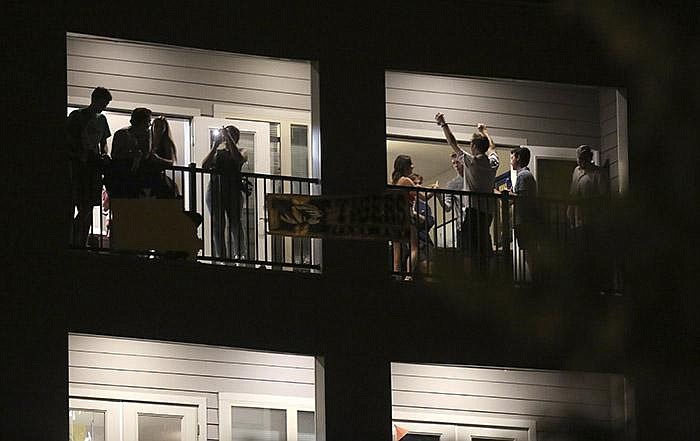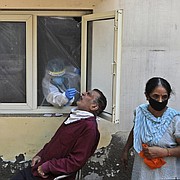STORRS, Conn. -- With the coronavirus spreading through colleges at alarming rates, universities are scrambling to find quarantine locations in dormitory buildings and off-campus properties to isolate the thousands of students who have caught covid-19 or been exposed to it.
Separately, President Donald Trump is urging Americans to "remain vigilant" about the coronavirus over the Labor Day weekend.
Trump said at a White House briefing Friday that "we need everybody to be careful" and to "apply common sense" in their interactions with one another.
Dr. Anthony Fauci, the nation's top infectious-disease expert, said last week that several states that have seen jumps in coronavirus caseloads should be especially vigilant during the holiday weekend. They are Arkansas, North Dakota, South Dakota, Iowa, Illinois, Indiana and Missouri.
Sacred Heart University has converted a 34-room guesthouse at the former Connecticut headquarters of General Electric to quarantine students. The University of South Carolina ran out of space at a dormitory for quarantined students and began sending them to rooms it rented in hotel-like quarters at a training center for prosecutors. The Air Force Academy sent 400 cadets to hotels to free up space on its Colorado base for quarantines.
[Video not showing up above? Click here to view » https://www.youtube.com/watch?v=VAvLrH6OIJ0]
The actions again demonstrate how the virus has uprooted traditional campus life amid a pandemic that has killed nearly 190,000 people in the U.S. and proved to be especially problematic for universities since the start of the school year. Many colleges quickly scrapped in-person learning in favor of online after cases began to spike, bars have been shut down in college towns, and students, fraternities and sororities have been repeatedly disciplined for parties and large gatherings.
Health officials, such as White House coronavirus task force member Dr. Deborah Birx, have been urging colleges to keep students on campus to avoid them infecting members of their family and community.
At Sacred Heart, which acquired the 66-acre GE campus in 2016, the guesthouse that once provided rooms for visiting corporate executives will be used for the rest of the year to isolate any of its 3,000 students who test positive for covid-19 and are unable to return home, said Gary MacNamara, the school's director of public safety.
Rooms are stocked with snacks, and equipped with TVs and work stations for remote learning. Health officials will do periodic checkups, security is stationed outside and card swipes keep track of who enters or leaves.
Ryan Bologna has been locked in his dorm room at the University of Connecticut since 12 cases were found in his building last week. He's allowed to go to a dining hall next door, but has had no other contact with the outside world.
Zoom classes, virtual marching band practice and video gaming are not what the communications major had envisioned for the start of his senior year.
"I do have friends I've made throughout the years that I can talk to," he said. "But if I were a freshman, I'd be really struggling right now as far as the social aspect."
Isolating students seems to be working in states like Connecticut, where the infection rate at the University of Connecticut on Thursday was 1.34% among residential students tested for the virus.
CAMPUS CASES
But the results haven't been as good elsewhere.
The University of Alabama recently informed students in half of a five-story complex that they had to move to other housing to make room for infected or potentially infected students because two other quarantine-and-isolation facilities would reach capacity.
So far, more than 1,000 students on the Tuscaloosa campus have tested positive since mid-August. As of Thursday, the system's online dashboard showed that its quarantine housing was 36% full.
The university banned on-campus events for two weeks, and the city of Tuscaloosa ordered bars closed amid concern about virus spread. The football-obsessed school is still planning to allow fans for games -- with a ban on tailgating -- when the Crimson Tide begins its season this month.
The University of South Carolina has about 35,000 students on its main Columbia campus. More than 1,400 have tested positive for covid-19 so far, with many more ordered into quarantine after exposure to covid-positive students.
They were first housed in a dormitory called Bates West, where some students are allowed to room together. But once that filled up, the university began sending students off-campus to a training center for prosecutors.
"We do feel like we can surge additional space, either on campus or nearby, to support the students," said Larry Thomas, a school spokesman.
Brown University in Rhode Island has delayed the start of in-person learning until next month at the earliest because of concerns over where to put people who might test positive. Schools such as Georgia College & State University, a 7,000-student school in Milledgeville that has reported more than 600 cases since the beginning of August, are telling students that if they have covid-19, they should leave campus.
HOME OR QUARANTINE?
There's a debate in the health community about whether to send students home or keep them in quarantine.
Dr. Joseph Gerald, associate professor of public health policy and management at the University of Arizona, said the idea of identifying cases, contact tracing and quarantining is the right approach. He said it's just going to be hard to do in dorms, fraternity houses or places where students congregate.
"One of the things we're struggling with here at the University of Arizona is what to do with multistory buildings, where kids need to get to their rooms, but we have one or two elevators," he said. "It's not really possible to make an elevator safe."
Dr. Peter Hotez, a Baylor College of Medicine infectious-disease expert, dean of the National School for Tropical Medicine and co-director of Texas Children's Hospital Center for Vaccine Development, said many colleges simply cannot open safely.
"There's only so much you can do with Plexiglas and social distancing and testing," he said. "That will help get you about 20% to 30% of the way, the other 70% is whether you have an adequate suppression of transmission. You might get away with it at Bowdoin College ... but clearly it's going to fail at the University of Alabama, the University of Georgia and places like that."
In a New York Times review of 203 counties in the country where students comprise at least 10% of the population, about half experienced their worst weeks of the pandemic since Aug. 1. In about half of those, figures showed the number of new infections is peaking right now.
Despite the surge in cases, there has been no uptick in deaths in college communities, data shows. This suggests that most of the infections are stemming from campuses, since young people who contract the virus are far less likely to die than are older people. However, leaders fear that young people who are infected will contribute to a spread of the virus throughout the community.
COLLEGE SURGES
The surge in infections reported by county health departments comes as many college administrations are also disclosing clusters on their campuses.
• Brazos County, Texas, home to Texas A&M University, added 742 new coronavirus cases during the last week of August, the county's worst week so far.
• Pitt County, North Carolina, site of East Carolina University, saw its coronavirus cases rise above 800 in a single week at the end of August. The Times has identified at least 846 infections involving students, and faculty and staff members since mid-August.
• In South Dakota's Clay and Brookings counties, ballooning infections in the past two weeks have reflected outbreaks at the state's major universities.
• In McLean County, Illinois, the virus has been spreading as more than 1,200 people have contracted it at Illinois State University.
[Gallery not loading above? Click here for more photos » arkansasonline.com/96covid/]
• At Washington State University and the University of Idaho, about 8 miles apart, combined coronavirus cases have risen since early July to more than 300 infections. In the surrounding communities -- rural Whitman County, Washington, and Latah County, Idaho -- cases per week have climbed from low single-digits in the first three months of the pandemic, to double-digits in July, to more than 300 cases in the last week of August.
The Times has collected infection data from state and local health departments and individual colleges. Academic institutions generally report cases involving students, and faculty and staff members, while the countywide data includes infections for all residents of the county.
It's unclear precisely how the figures overlap and how many infections in a community outside of campus are definitively tied to campus outbreaks.
But epidemiologists have warned that, even with exceptional contact tracing, it would be difficult to completely contain the virus on a campus when students shop, eat and drink in town, and local residents work at the college.
The pandemic has hurt colleges' finances in multiple ways, adding pressure on many schools to get students back to campus. It has caused enrollment declines as students have opted for gap years or chosen to stay closer to home, added substantial costs for safety measures, reduced revenue from student room and board, and canceled money-generating athletic events.
AROUND THE WORLD
Elsewhere in the world, India's coronavirus caseload surpassed 4 million Saturday, deepening misery in the country's vast hinterlands, where surges have crippled the underfunded health care system.
Initially, the virus ravaged India's sprawling and densely populated cities. It has since stretched to almost every state, spreading through villages and small towns.
For more than two months, the economy remained shuttered, buying time for health workers to prepare for the worst.
But with the cost of the restrictions also rising, authorities saw no choice but to reopen businesses and everyday activities.
In Italy, the daily number of coronavirus deaths has been rising, with 16 registered Saturday by the Health Ministry.
That's five more than the previous day. However, those numbers are dramatically lower than in the early weeks of the pandemic in the nation, when hundreds of people were dying daily.
Meanwhile, the personal doctor of Silvio Berlusconi has expressed "cautious but reasonable optimism" for the former Italian leader's recovery from the coronavirus.
The 83-year-old Berlusconi was hospitalized in Milan after testing positive last week.
Dr. Alberto Zangrillo said in a written statement Saturday that Berlusconi's clinical condition remains stable.
Separately, Pope Francis will visit Assisi next month, in his first visit outside Rome since the coronavirus pandemic.
[CORONAVIRUS: Click here for our complete coverage » arkansasonline.com/coronavirus]
He'll journey to Assisi, the birthplace in the central Italian region of Umbria of his namesake saint. He'll sign an authoritative papal letter to clergy and faithful worldwide, the Vatican said Saturday.
The encyclical is expected to stress the value of brotherly relations during and after the pandemic.
Information for this article was contributed by Pat Eaton-Robb, Jeff Amy, Haleluya Hadero, Sheikh Saaliq, Biswajeet Banerjee and Aniruddha Ghosal of The Associated Press; and by Sarah Watson, Shawn Hubler, Danielle Ivory and Robert Gebeloff of The New York Times.








